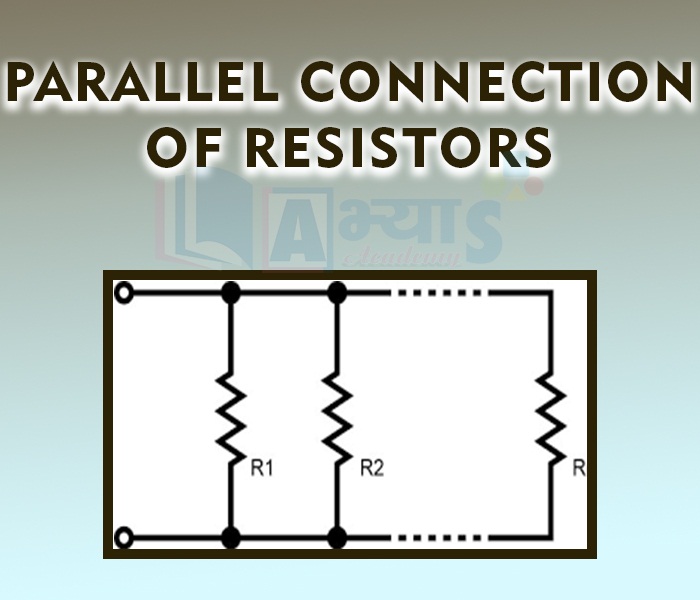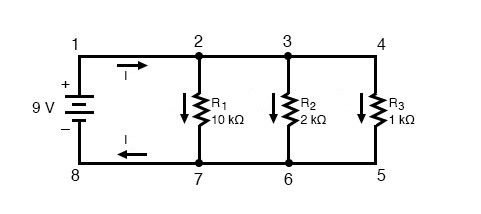Parallel Connection of Resistors












Parallel Connection of Resistors
When two or more resistors are connected simultaneously between two points that is first ends of all the resistors are connected to one point and the all the second ends are connected to the other point, then they form a parallel combination. In this combination, the potential difference between the ends of all the resistances is same but the current is different in different resistance.
In this combination more than one resistance is connected as shown. In this type of circuit:

1. Equal potential difference across each resistance.
2. Total current flowing through the combination is equal to the sum of current flowing through each resistance.
3. Current through each resistance can be calculated using Ohm’s Law and is proportional to the value of resistance.
4. Equivalent resistance is less than resistance of any resistor in the circuit.. This is also known as minimum effective resistance
In the circuit given we have three resistance R1, R2 and R3 are connected in parallel and I1, I2 and I3 are the current flowing through each resistance respectively. If V is the potential difference across the combination the equivalent resistance can be calculated as
Total current is the sum of current flowing through each resistance,then
.....(i)
By Ohm s law,
.....(ii)
If R is the equivalent resistance, then
.....(iii)
Thus the values from equation (2) and (3) in (1) we get
Some important points regarding parallel combination of resistors are as follows :
Parallel combination of resistances is highly useful in circuits used in daily life as the circuits can have components of different resistances and different amounts of current can flow through them. The total resistance in a parallel circuit decreases which helps in the condition that each gadget has different resistances in a circuit and requires different amounts of current to operate. Parallel circuit divides the current among the components (electrical gadgets), so that they can have necessary amount of current to operate properly.
This is the reason of connecting electrical appliances in parallel combination in household circuit.
Illustration: In the circuit given below calculate the current flowing through each resistor.and verify the relationship of current in parallel connections.

Solution: In the circuit we have two resistance R1, R2 and R3 which are connected in parallel to battery of 9 V. The equivalent resistance can be calculated as
Substituting the value of resistance we get
Now as the battery is of 9 V, Then according to Ohm's Law
V= IR
Current through effective resistance (Rp ) is
For parallel combination of resistance, let us verify the relationship
L.H.S. = R.H.S
Hence the relation is verified.
In our houses all electrical devices operate on 220 V it implies that- | |||
| Right Option : A | |||
| View Explanation | |||
In a circuit if three resistance of 3ohms each are connected in parallel then what is the net resistance | |||
| Right Option : C | |||
| View Explanation | |||
In a circuit if three resistance of 1ohms, 2 ohms and 3 ohms are connected in parallel then what is the net resistance | |||
| Right Option : C | |||
| View Explanation | |||
Students / Parents Reviews [20]
The experience was nice. I studied here for three years and saw a tremendous change in myself. I started liking subjects like English and SST which earlier I ran from. Extra knowledge gave me confidence to overcome competitive exams. One of the best institutes for secondary education.

Aman Kumar Shrivastava
10thIt was good as the experience because as we had come here we had been improved in a such envirnment created here.Extra is taught which is beneficial for future.

Eshan Arora
8thThird consective year,my ward is in Abhyas with nice experience of admin and transport support.Educational standard of the institute recumbent at satisfactory level. One thing would live to bring in notice that last year study books was distributed after half of the session was over,though study ...

Ayan Ghosh
8thAbhyas is good institution and a innovative institute also. It is a good platform of beginners.Due to Abhyas,he has got knoweledge about reasoning and confidence.My son has improved his vocabulary because of Abhyas.Teacher have very friendly atmosphere also.

Manish Kumar
10thUsually we see institutes offering objective based learning which usually causes a lag behind in subjective examinations which is the pattern followed by schools. I think it is really a work of planning to make us students grab the advantages of modes of examination, Objective Subjective and Onli...

Anika Saxena
8thAbhyas institute is one of the best coaching institute in the vicinity of Ambala Cantt area. The teachers of the institute are well experienced and very helpful in solving the problems of the students.The good thing of the institute is that it is providing extra classes for the students who are w...

Aman Kumar Shrivastava
10thAbhyas is an institute of high repute. Yogansh has taken admission last year. It creates abilities in child to prepare for competitive exams. Students are motivated by living prizes on basis of performance in Abhyas exams. He is satisfied with institute.

Yogansh Nyasi
7thWe started with lot of hope that Abhyas will help in better understnding of complex topics of highers classes. we are not disappointed with the progress our child has made after attending Abhyas. Though need to mention that we expected a lot more. On a scale of 1-10, we would give may be 7.

Manya
8thIt has a great methodology. Students here can get analysis to their test quickly.We can learn easily through PPTs and the testing methods are good. We know that where we have to practice

Barkha Arora
10thAbout Abhyas metholodology the teachers are very nice and hardworking toward students.The Centre Head Mrs Anu Sethi is also a brilliant teacher.Abhyas has taught me how to overcome problems and has always taken my doubts and suppoeted me.

Shreya Shrivastava
8thIt was a good experience with Abhyas Academy. I even faced problems in starting but slowly and steadily overcomed. Especially reasoning classes helped me a lot.

Cheshta
10thAbhyas academy is great place to learn. I have learnt a lot here they have finished my fear of not answering.It has created a habit of self studying in me.The teachers here are very supportive and helpful. Earlier my maths and science was good but now it has been much better than before.

Barkha Arora
10thAbhyas is a complete education Institute. Here extreme care is taken by teacher with the help of regular exam. Extra classes also conducted by the institute, if the student is weak.

Om Umang
10thMy experience with Abhyas is very good. I have learnt many things here like vedic maths and reasoning also. Teachers here first take our doubts and then there are assignments to verify our weak points.

Shivam Rana
7thI have spent a wonderful time in Abhyas academy. It has made my reasoning more apt, English more stronger and Maths an interesting subject for me. It has given me a habbit of self studying

Yatharthi Sharma
10thIn terms of methodology I want to say that institute provides expert guidence and results oriented monitering supplements by requsite study material along with regular tests which help the students to improve their education skills.The techniques of providing education helps the students to asses...

Aman Kumar Shrivastava
10thAbhyas institute is one of the best coaching institute in the vicinity of Ambala cantt.The institute provides good and quality education to the students.The teachers are well experienced and are very helpful in solving the problems. The major advantages of the institute is extra classes for weak...

Shreya Shrivastava
8thAbhyas Methodology is very good. It is based on according to student and each child manages accordingly to its properly. Methodology has improved the abilities of students to shine them in future.

Manish Kumar
10thOne of the best institutes to develope a child interest in studies.Provides SST and English knowledge also unlike other institutes. Teachers are co operative and friendly online tests andPPT develope practical knowledge also.

Aman Kumar Shrivastava
10thMy experience with Abhyas academy is very good. I did not think that my every subject coming here will be so strong. The main thing is that the online tests had made me learn here more things.
